Implications of English Proficiency on Workplace Safety in Singapore
VerifiedAdded on 2021/04/17
|35
|7745
|350
Thesis and Dissertation
AI Summary
This dissertation examines the implications of limited English language proficiency on Workplace Safety and Health (WSH) within five construction companies in Singapore. The study, based on a survey of 50 employees, investigates the correlation between English proficiency and the understanding of WSH policies. The research aims to determine how language skills affect the interpretation and implementation of safety regulations, particularly within a multicultural workforce. The findings suggest that English proficiency plays a crucial role in effective communication and comprehension of safety protocols, potentially influencing employee safety and the overall WSH environment. The study concludes by highlighting the benefits of English language skills for both employees and organizations in ensuring better understanding and adherence to WSH standards, especially in multinational companies. The research also provides recommendations and identifies limitations for future research in this area.
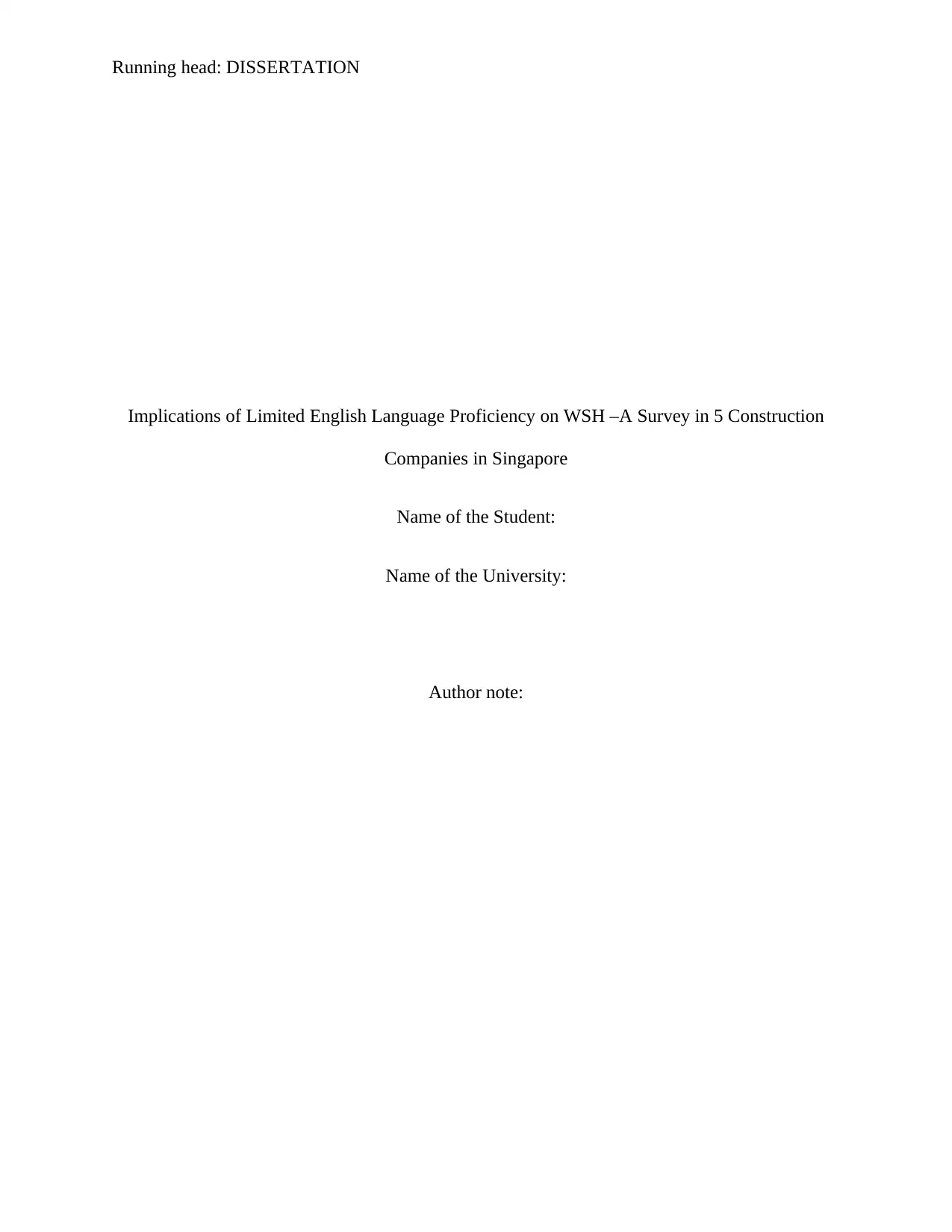
Running head: DISSERTATION
Implications of Limited English Language Proficiency on WSH –A Survey in 5 Construction
Companies in Singapore
Name of the Student:
Name of the University:
Author note:
Implications of Limited English Language Proficiency on WSH –A Survey in 5 Construction
Companies in Singapore
Name of the Student:
Name of the University:
Author note:
Paraphrase This Document
Need a fresh take? Get an instant paraphrase of this document with our AI Paraphraser
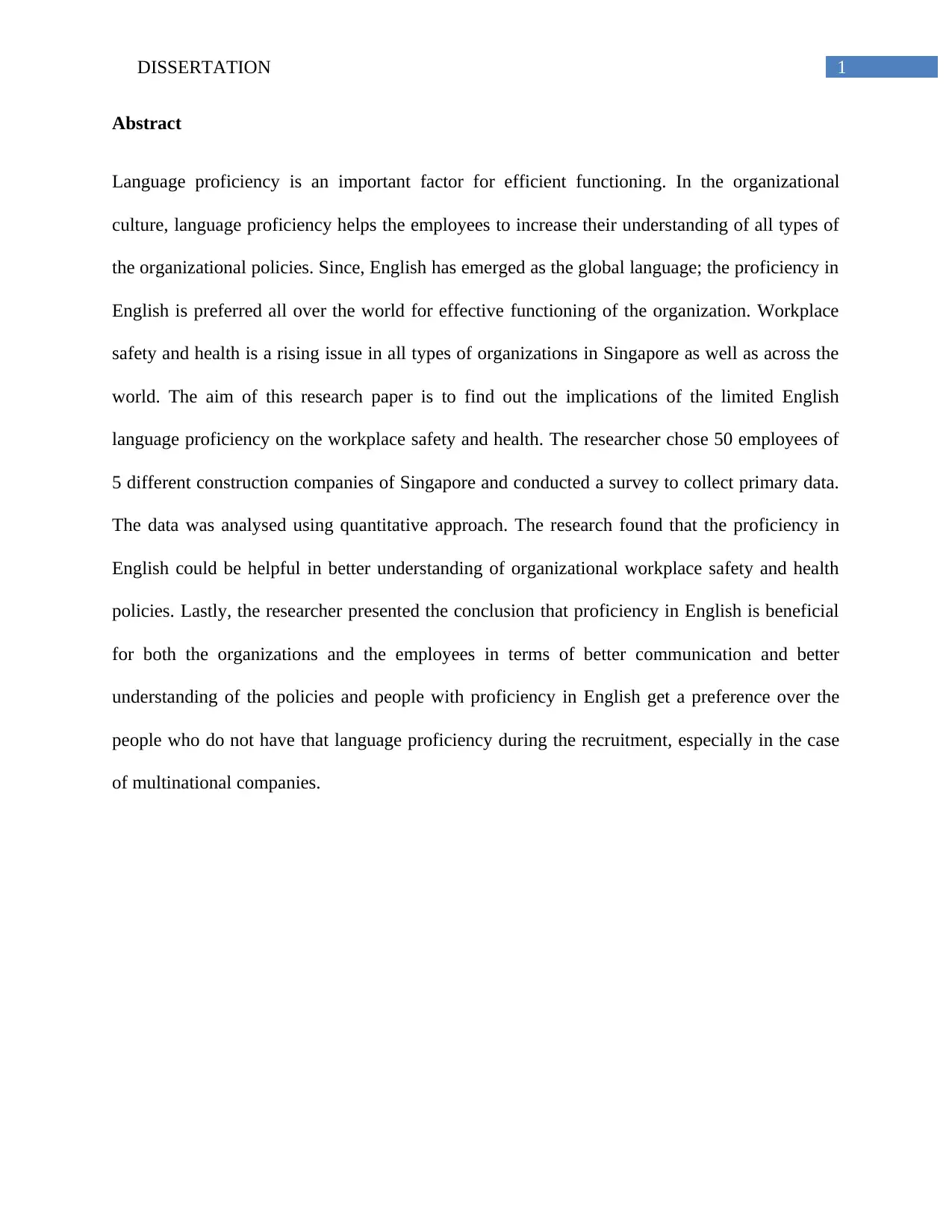
1DISSERTATION
Abstract
Language proficiency is an important factor for efficient functioning. In the organizational
culture, language proficiency helps the employees to increase their understanding of all types of
the organizational policies. Since, English has emerged as the global language; the proficiency in
English is preferred all over the world for effective functioning of the organization. Workplace
safety and health is a rising issue in all types of organizations in Singapore as well as across the
world. The aim of this research paper is to find out the implications of the limited English
language proficiency on the workplace safety and health. The researcher chose 50 employees of
5 different construction companies of Singapore and conducted a survey to collect primary data.
The data was analysed using quantitative approach. The research found that the proficiency in
English could be helpful in better understanding of organizational workplace safety and health
policies. Lastly, the researcher presented the conclusion that proficiency in English is beneficial
for both the organizations and the employees in terms of better communication and better
understanding of the policies and people with proficiency in English get a preference over the
people who do not have that language proficiency during the recruitment, especially in the case
of multinational companies.
Abstract
Language proficiency is an important factor for efficient functioning. In the organizational
culture, language proficiency helps the employees to increase their understanding of all types of
the organizational policies. Since, English has emerged as the global language; the proficiency in
English is preferred all over the world for effective functioning of the organization. Workplace
safety and health is a rising issue in all types of organizations in Singapore as well as across the
world. The aim of this research paper is to find out the implications of the limited English
language proficiency on the workplace safety and health. The researcher chose 50 employees of
5 different construction companies of Singapore and conducted a survey to collect primary data.
The data was analysed using quantitative approach. The research found that the proficiency in
English could be helpful in better understanding of organizational workplace safety and health
policies. Lastly, the researcher presented the conclusion that proficiency in English is beneficial
for both the organizations and the employees in terms of better communication and better
understanding of the policies and people with proficiency in English get a preference over the
people who do not have that language proficiency during the recruitment, especially in the case
of multinational companies.
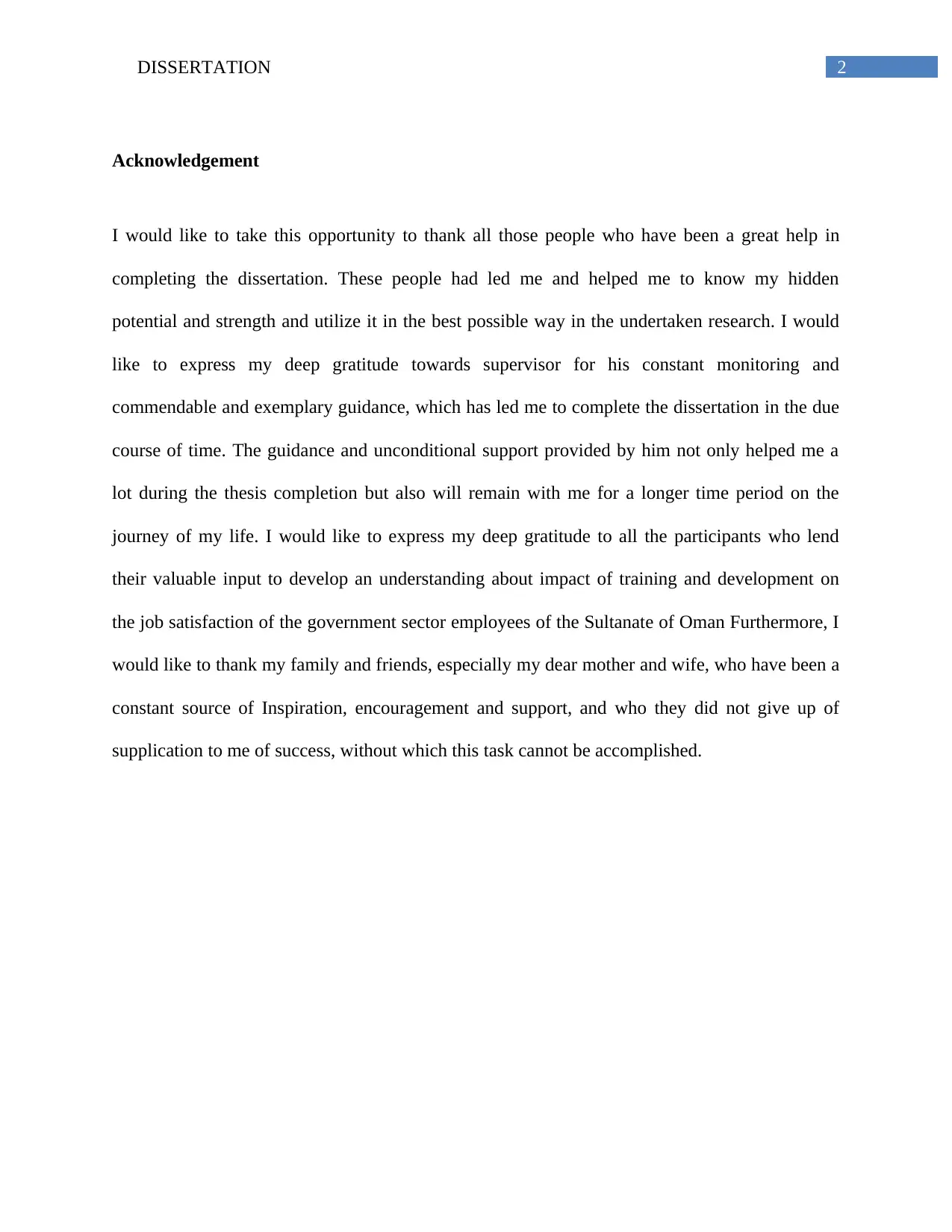
2DISSERTATION
Acknowledgement
I would like to take this opportunity to thank all those people who have been a great help in
completing the dissertation. These people had led me and helped me to know my hidden
potential and strength and utilize it in the best possible way in the undertaken research. I would
like to express my deep gratitude towards supervisor for his constant monitoring and
commendable and exemplary guidance, which has led me to complete the dissertation in the due
course of time. The guidance and unconditional support provided by him not only helped me a
lot during the thesis completion but also will remain with me for a longer time period on the
journey of my life. I would like to express my deep gratitude to all the participants who lend
their valuable input to develop an understanding about impact of training and development on
the job satisfaction of the government sector employees of the Sultanate of Oman Furthermore, I
would like to thank my family and friends, especially my dear mother and wife, who have been a
constant source of Inspiration, encouragement and support, and who they did not give up of
supplication to me of success, without which this task cannot be accomplished.
Acknowledgement
I would like to take this opportunity to thank all those people who have been a great help in
completing the dissertation. These people had led me and helped me to know my hidden
potential and strength and utilize it in the best possible way in the undertaken research. I would
like to express my deep gratitude towards supervisor for his constant monitoring and
commendable and exemplary guidance, which has led me to complete the dissertation in the due
course of time. The guidance and unconditional support provided by him not only helped me a
lot during the thesis completion but also will remain with me for a longer time period on the
journey of my life. I would like to express my deep gratitude to all the participants who lend
their valuable input to develop an understanding about impact of training and development on
the job satisfaction of the government sector employees of the Sultanate of Oman Furthermore, I
would like to thank my family and friends, especially my dear mother and wife, who have been a
constant source of Inspiration, encouragement and support, and who they did not give up of
supplication to me of success, without which this task cannot be accomplished.
⊘ This is a preview!⊘
Do you want full access?
Subscribe today to unlock all pages.

Trusted by 1+ million students worldwide
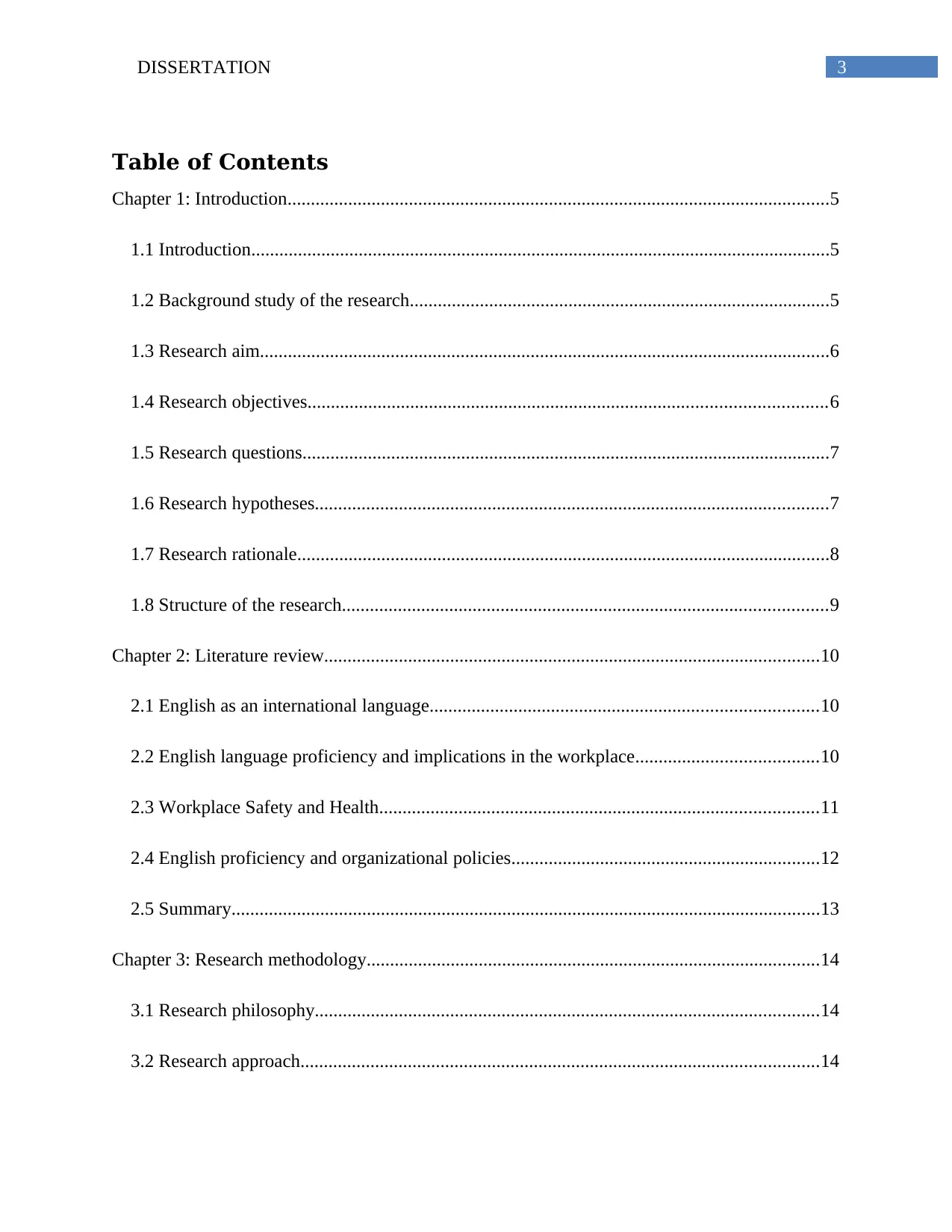
3DISSERTATION
Table of Contents
Chapter 1: Introduction....................................................................................................................5
1.1 Introduction............................................................................................................................5
1.2 Background study of the research..........................................................................................5
1.3 Research aim..........................................................................................................................6
1.4 Research objectives...............................................................................................................6
1.5 Research questions.................................................................................................................7
1.6 Research hypotheses..............................................................................................................7
1.7 Research rationale..................................................................................................................8
1.8 Structure of the research........................................................................................................9
Chapter 2: Literature review..........................................................................................................10
2.1 English as an international language...................................................................................10
2.2 English language proficiency and implications in the workplace.......................................10
2.3 Workplace Safety and Health..............................................................................................11
2.4 English proficiency and organizational policies..................................................................12
2.5 Summary..............................................................................................................................13
Chapter 3: Research methodology.................................................................................................14
3.1 Research philosophy............................................................................................................14
3.2 Research approach...............................................................................................................14
Table of Contents
Chapter 1: Introduction....................................................................................................................5
1.1 Introduction............................................................................................................................5
1.2 Background study of the research..........................................................................................5
1.3 Research aim..........................................................................................................................6
1.4 Research objectives...............................................................................................................6
1.5 Research questions.................................................................................................................7
1.6 Research hypotheses..............................................................................................................7
1.7 Research rationale..................................................................................................................8
1.8 Structure of the research........................................................................................................9
Chapter 2: Literature review..........................................................................................................10
2.1 English as an international language...................................................................................10
2.2 English language proficiency and implications in the workplace.......................................10
2.3 Workplace Safety and Health..............................................................................................11
2.4 English proficiency and organizational policies..................................................................12
2.5 Summary..............................................................................................................................13
Chapter 3: Research methodology.................................................................................................14
3.1 Research philosophy............................................................................................................14
3.2 Research approach...............................................................................................................14
Paraphrase This Document
Need a fresh take? Get an instant paraphrase of this document with our AI Paraphraser
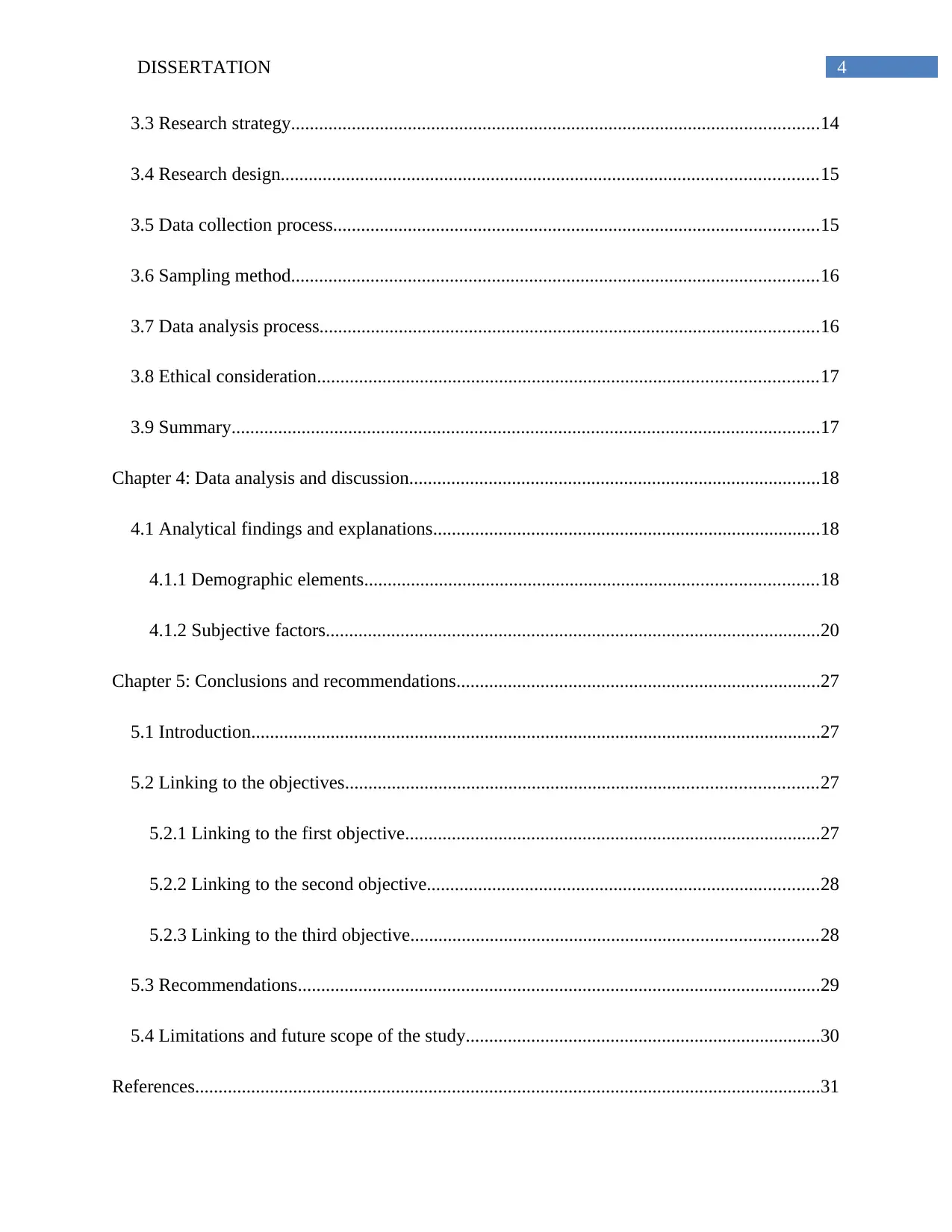
4DISSERTATION
3.3 Research strategy.................................................................................................................14
3.4 Research design...................................................................................................................15
3.5 Data collection process........................................................................................................15
3.6 Sampling method.................................................................................................................16
3.7 Data analysis process...........................................................................................................16
3.8 Ethical consideration...........................................................................................................17
3.9 Summary..............................................................................................................................17
Chapter 4: Data analysis and discussion........................................................................................18
4.1 Analytical findings and explanations...................................................................................18
4.1.1 Demographic elements.................................................................................................18
4.1.2 Subjective factors..........................................................................................................20
Chapter 5: Conclusions and recommendations..............................................................................27
5.1 Introduction..........................................................................................................................27
5.2 Linking to the objectives.....................................................................................................27
5.2.1 Linking to the first objective.........................................................................................27
5.2.2 Linking to the second objective....................................................................................28
5.2.3 Linking to the third objective.......................................................................................28
5.3 Recommendations................................................................................................................29
5.4 Limitations and future scope of the study............................................................................30
References......................................................................................................................................31
3.3 Research strategy.................................................................................................................14
3.4 Research design...................................................................................................................15
3.5 Data collection process........................................................................................................15
3.6 Sampling method.................................................................................................................16
3.7 Data analysis process...........................................................................................................16
3.8 Ethical consideration...........................................................................................................17
3.9 Summary..............................................................................................................................17
Chapter 4: Data analysis and discussion........................................................................................18
4.1 Analytical findings and explanations...................................................................................18
4.1.1 Demographic elements.................................................................................................18
4.1.2 Subjective factors..........................................................................................................20
Chapter 5: Conclusions and recommendations..............................................................................27
5.1 Introduction..........................................................................................................................27
5.2 Linking to the objectives.....................................................................................................27
5.2.1 Linking to the first objective.........................................................................................27
5.2.2 Linking to the second objective....................................................................................28
5.2.3 Linking to the third objective.......................................................................................28
5.3 Recommendations................................................................................................................29
5.4 Limitations and future scope of the study............................................................................30
References......................................................................................................................................31
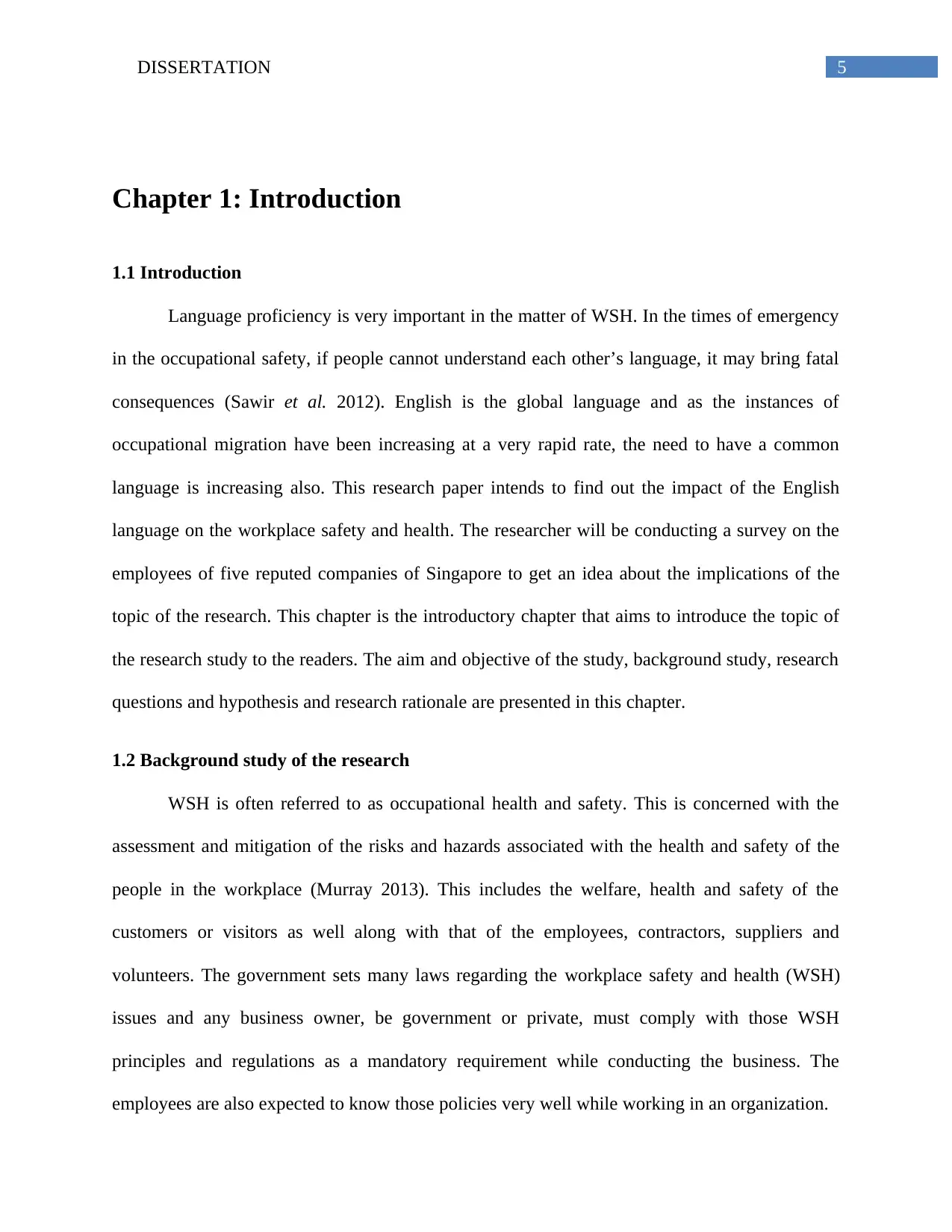
5DISSERTATION
Chapter 1: Introduction
1.1 Introduction
Language proficiency is very important in the matter of WSH. In the times of emergency
in the occupational safety, if people cannot understand each other’s language, it may bring fatal
consequences (Sawir et al. 2012). English is the global language and as the instances of
occupational migration have been increasing at a very rapid rate, the need to have a common
language is increasing also. This research paper intends to find out the impact of the English
language on the workplace safety and health. The researcher will be conducting a survey on the
employees of five reputed companies of Singapore to get an idea about the implications of the
topic of the research. This chapter is the introductory chapter that aims to introduce the topic of
the research study to the readers. The aim and objective of the study, background study, research
questions and hypothesis and research rationale are presented in this chapter.
1.2 Background study of the research
WSH is often referred to as occupational health and safety. This is concerned with the
assessment and mitigation of the risks and hazards associated with the health and safety of the
people in the workplace (Murray 2013). This includes the welfare, health and safety of the
customers or visitors as well along with that of the employees, contractors, suppliers and
volunteers. The government sets many laws regarding the workplace safety and health (WSH)
issues and any business owner, be government or private, must comply with those WSH
principles and regulations as a mandatory requirement while conducting the business. The
employees are also expected to know those policies very well while working in an organization.
Chapter 1: Introduction
1.1 Introduction
Language proficiency is very important in the matter of WSH. In the times of emergency
in the occupational safety, if people cannot understand each other’s language, it may bring fatal
consequences (Sawir et al. 2012). English is the global language and as the instances of
occupational migration have been increasing at a very rapid rate, the need to have a common
language is increasing also. This research paper intends to find out the impact of the English
language on the workplace safety and health. The researcher will be conducting a survey on the
employees of five reputed companies of Singapore to get an idea about the implications of the
topic of the research. This chapter is the introductory chapter that aims to introduce the topic of
the research study to the readers. The aim and objective of the study, background study, research
questions and hypothesis and research rationale are presented in this chapter.
1.2 Background study of the research
WSH is often referred to as occupational health and safety. This is concerned with the
assessment and mitigation of the risks and hazards associated with the health and safety of the
people in the workplace (Murray 2013). This includes the welfare, health and safety of the
customers or visitors as well along with that of the employees, contractors, suppliers and
volunteers. The government sets many laws regarding the workplace safety and health (WSH)
issues and any business owner, be government or private, must comply with those WSH
principles and regulations as a mandatory requirement while conducting the business. The
employees are also expected to know those policies very well while working in an organization.
⊘ This is a preview!⊘
Do you want full access?
Subscribe today to unlock all pages.

Trusted by 1+ million students worldwide
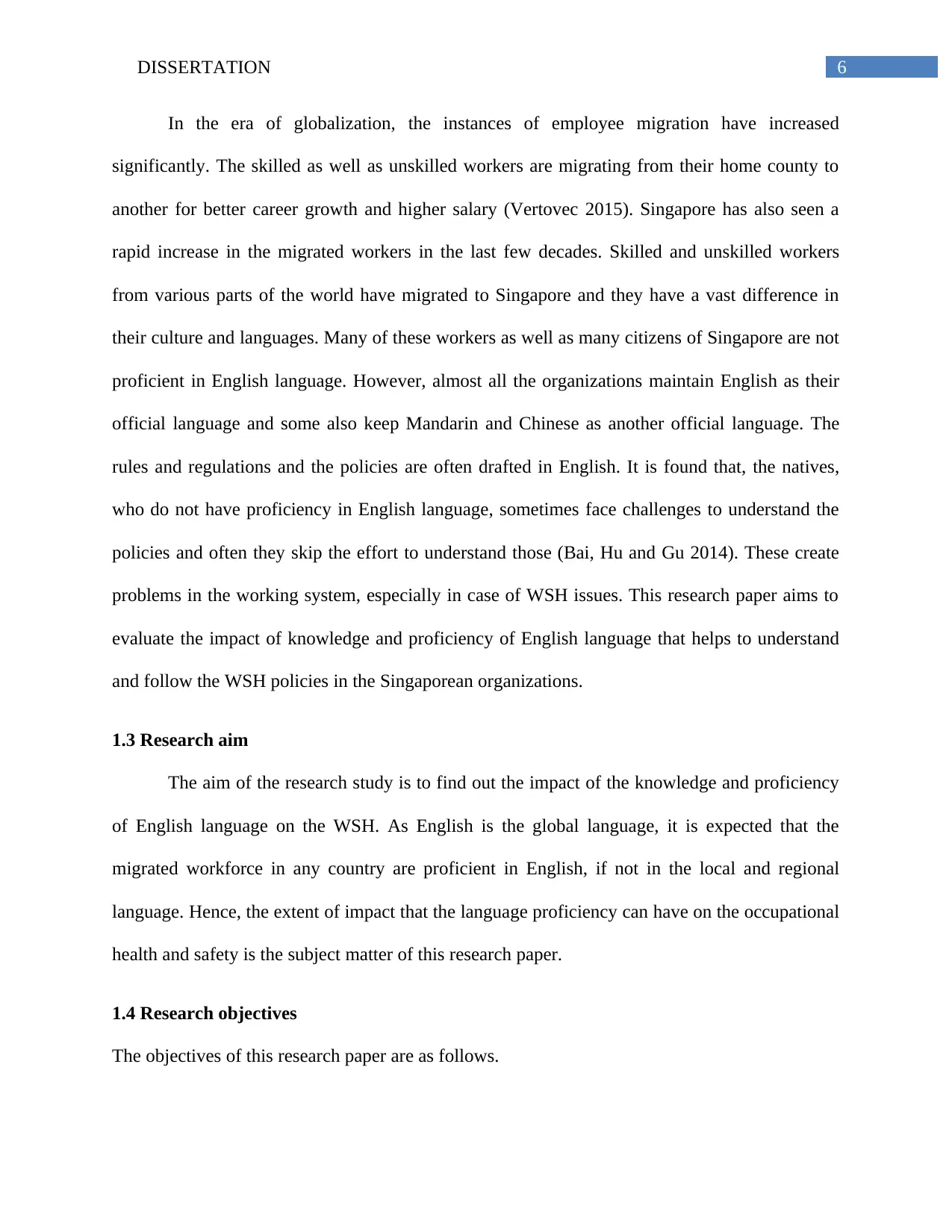
6DISSERTATION
In the era of globalization, the instances of employee migration have increased
significantly. The skilled as well as unskilled workers are migrating from their home county to
another for better career growth and higher salary (Vertovec 2015). Singapore has also seen a
rapid increase in the migrated workers in the last few decades. Skilled and unskilled workers
from various parts of the world have migrated to Singapore and they have a vast difference in
their culture and languages. Many of these workers as well as many citizens of Singapore are not
proficient in English language. However, almost all the organizations maintain English as their
official language and some also keep Mandarin and Chinese as another official language. The
rules and regulations and the policies are often drafted in English. It is found that, the natives,
who do not have proficiency in English language, sometimes face challenges to understand the
policies and often they skip the effort to understand those (Bai, Hu and Gu 2014). These create
problems in the working system, especially in case of WSH issues. This research paper aims to
evaluate the impact of knowledge and proficiency of English language that helps to understand
and follow the WSH policies in the Singaporean organizations.
1.3 Research aim
The aim of the research study is to find out the impact of the knowledge and proficiency
of English language on the WSH. As English is the global language, it is expected that the
migrated workforce in any country are proficient in English, if not in the local and regional
language. Hence, the extent of impact that the language proficiency can have on the occupational
health and safety is the subject matter of this research paper.
1.4 Research objectives
The objectives of this research paper are as follows.
In the era of globalization, the instances of employee migration have increased
significantly. The skilled as well as unskilled workers are migrating from their home county to
another for better career growth and higher salary (Vertovec 2015). Singapore has also seen a
rapid increase in the migrated workers in the last few decades. Skilled and unskilled workers
from various parts of the world have migrated to Singapore and they have a vast difference in
their culture and languages. Many of these workers as well as many citizens of Singapore are not
proficient in English language. However, almost all the organizations maintain English as their
official language and some also keep Mandarin and Chinese as another official language. The
rules and regulations and the policies are often drafted in English. It is found that, the natives,
who do not have proficiency in English language, sometimes face challenges to understand the
policies and often they skip the effort to understand those (Bai, Hu and Gu 2014). These create
problems in the working system, especially in case of WSH issues. This research paper aims to
evaluate the impact of knowledge and proficiency of English language that helps to understand
and follow the WSH policies in the Singaporean organizations.
1.3 Research aim
The aim of the research study is to find out the impact of the knowledge and proficiency
of English language on the WSH. As English is the global language, it is expected that the
migrated workforce in any country are proficient in English, if not in the local and regional
language. Hence, the extent of impact that the language proficiency can have on the occupational
health and safety is the subject matter of this research paper.
1.4 Research objectives
The objectives of this research paper are as follows.
Paraphrase This Document
Need a fresh take? Get an instant paraphrase of this document with our AI Paraphraser
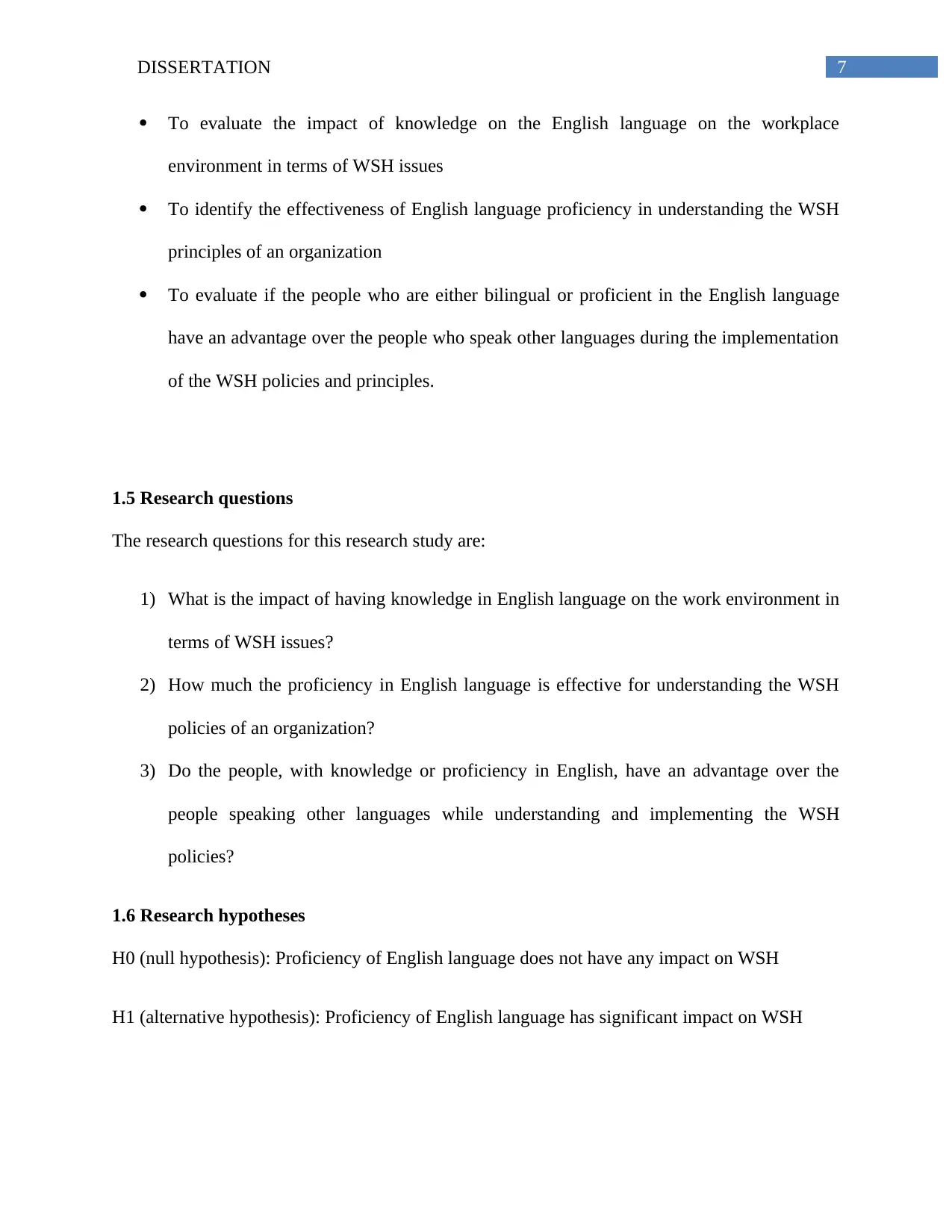
7DISSERTATION
To evaluate the impact of knowledge on the English language on the workplace
environment in terms of WSH issues
To identify the effectiveness of English language proficiency in understanding the WSH
principles of an organization
To evaluate if the people who are either bilingual or proficient in the English language
have an advantage over the people who speak other languages during the implementation
of the WSH policies and principles.
1.5 Research questions
The research questions for this research study are:
1) What is the impact of having knowledge in English language on the work environment in
terms of WSH issues?
2) How much the proficiency in English language is effective for understanding the WSH
policies of an organization?
3) Do the people, with knowledge or proficiency in English, have an advantage over the
people speaking other languages while understanding and implementing the WSH
policies?
1.6 Research hypotheses
H0 (null hypothesis): Proficiency of English language does not have any impact on WSH
H1 (alternative hypothesis): Proficiency of English language has significant impact on WSH
To evaluate the impact of knowledge on the English language on the workplace
environment in terms of WSH issues
To identify the effectiveness of English language proficiency in understanding the WSH
principles of an organization
To evaluate if the people who are either bilingual or proficient in the English language
have an advantage over the people who speak other languages during the implementation
of the WSH policies and principles.
1.5 Research questions
The research questions for this research study are:
1) What is the impact of having knowledge in English language on the work environment in
terms of WSH issues?
2) How much the proficiency in English language is effective for understanding the WSH
policies of an organization?
3) Do the people, with knowledge or proficiency in English, have an advantage over the
people speaking other languages while understanding and implementing the WSH
policies?
1.6 Research hypotheses
H0 (null hypothesis): Proficiency of English language does not have any impact on WSH
H1 (alternative hypothesis): Proficiency of English language has significant impact on WSH
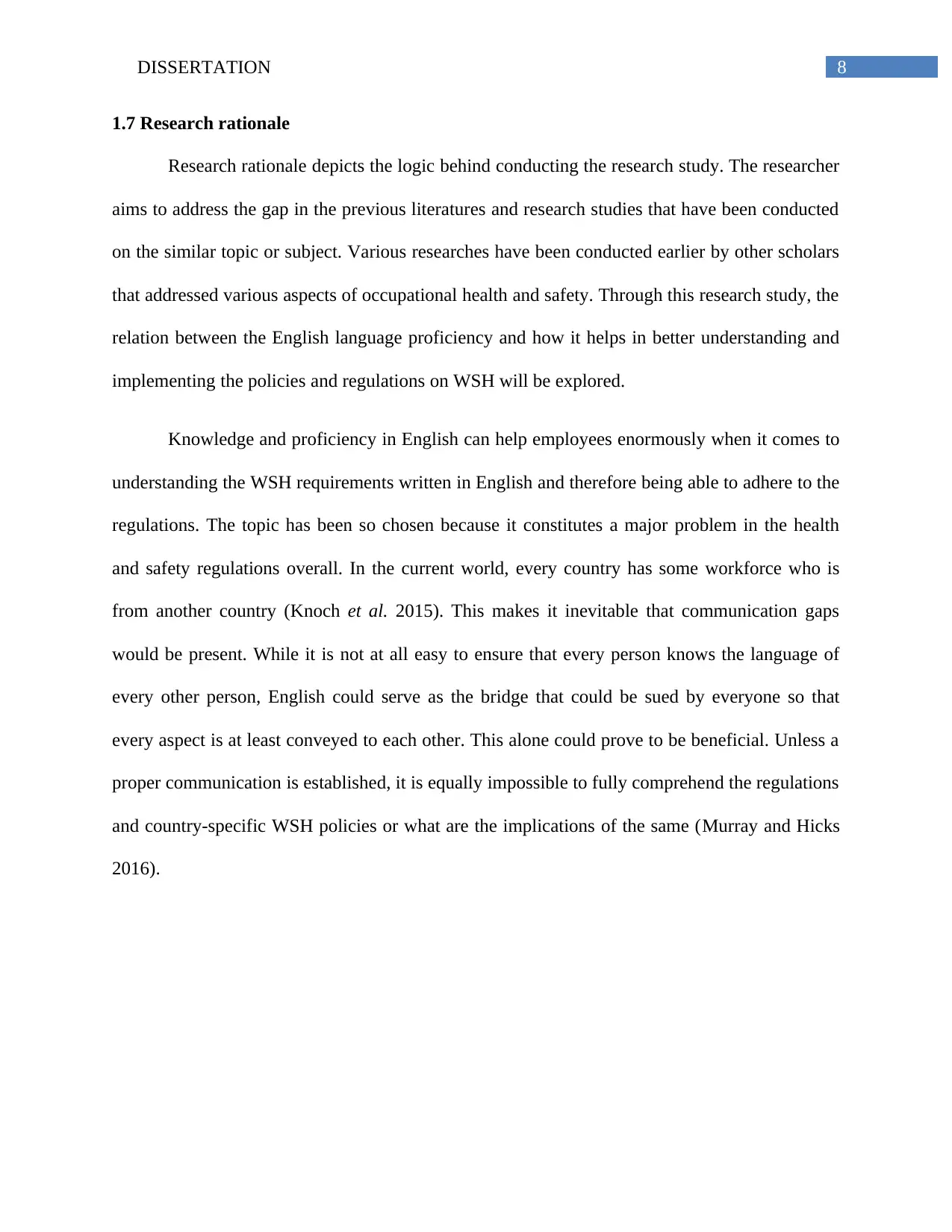
8DISSERTATION
1.7 Research rationale
Research rationale depicts the logic behind conducting the research study. The researcher
aims to address the gap in the previous literatures and research studies that have been conducted
on the similar topic or subject. Various researches have been conducted earlier by other scholars
that addressed various aspects of occupational health and safety. Through this research study, the
relation between the English language proficiency and how it helps in better understanding and
implementing the policies and regulations on WSH will be explored.
Knowledge and proficiency in English can help employees enormously when it comes to
understanding the WSH requirements written in English and therefore being able to adhere to the
regulations. The topic has been so chosen because it constitutes a major problem in the health
and safety regulations overall. In the current world, every country has some workforce who is
from another country (Knoch et al. 2015). This makes it inevitable that communication gaps
would be present. While it is not at all easy to ensure that every person knows the language of
every other person, English could serve as the bridge that could be sued by everyone so that
every aspect is at least conveyed to each other. This alone could prove to be beneficial. Unless a
proper communication is established, it is equally impossible to fully comprehend the regulations
and country-specific WSH policies or what are the implications of the same (Murray and Hicks
2016).
1.7 Research rationale
Research rationale depicts the logic behind conducting the research study. The researcher
aims to address the gap in the previous literatures and research studies that have been conducted
on the similar topic or subject. Various researches have been conducted earlier by other scholars
that addressed various aspects of occupational health and safety. Through this research study, the
relation between the English language proficiency and how it helps in better understanding and
implementing the policies and regulations on WSH will be explored.
Knowledge and proficiency in English can help employees enormously when it comes to
understanding the WSH requirements written in English and therefore being able to adhere to the
regulations. The topic has been so chosen because it constitutes a major problem in the health
and safety regulations overall. In the current world, every country has some workforce who is
from another country (Knoch et al. 2015). This makes it inevitable that communication gaps
would be present. While it is not at all easy to ensure that every person knows the language of
every other person, English could serve as the bridge that could be sued by everyone so that
every aspect is at least conveyed to each other. This alone could prove to be beneficial. Unless a
proper communication is established, it is equally impossible to fully comprehend the regulations
and country-specific WSH policies or what are the implications of the same (Murray and Hicks
2016).
⊘ This is a preview!⊘
Do you want full access?
Subscribe today to unlock all pages.

Trusted by 1+ million students worldwide
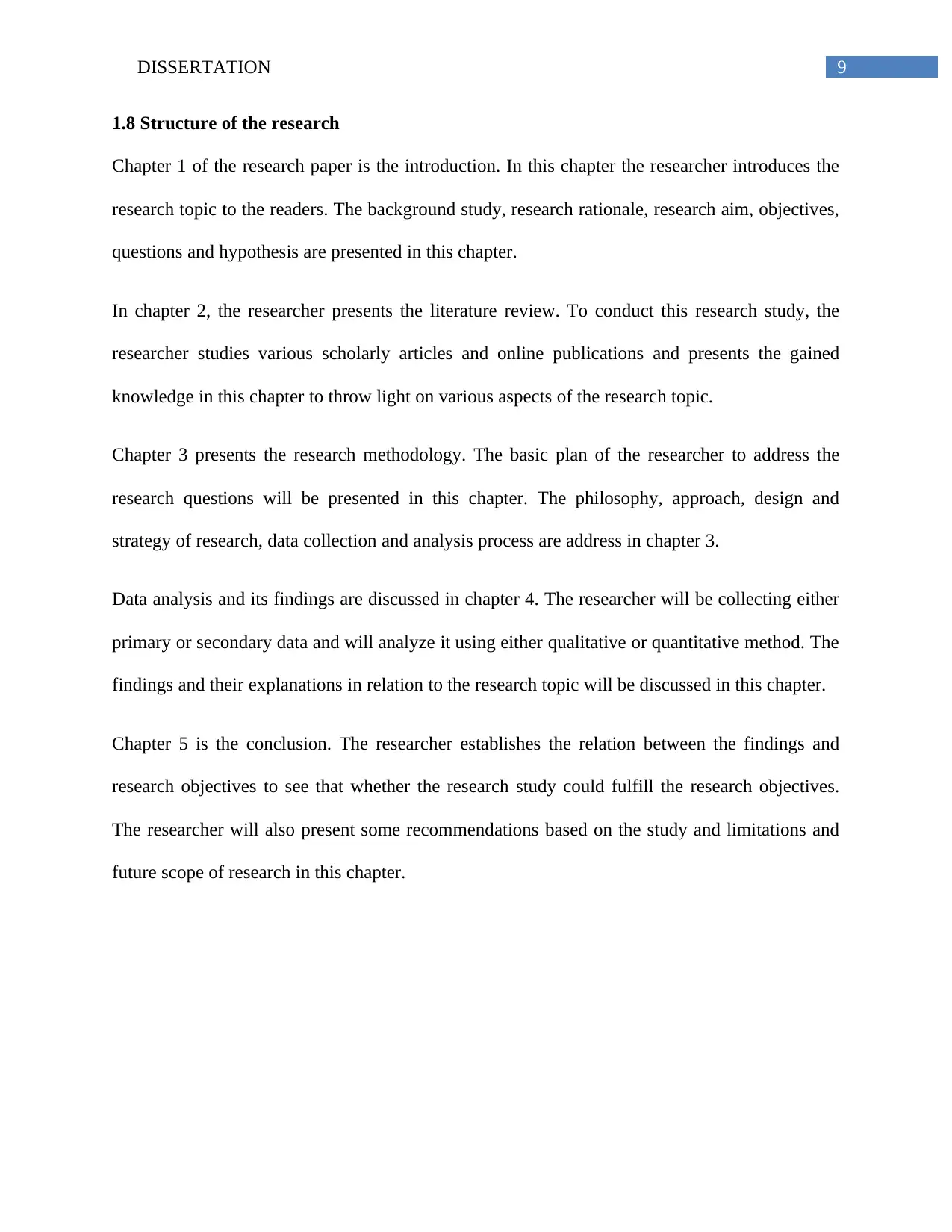
9DISSERTATION
1.8 Structure of the research
Chapter 1 of the research paper is the introduction. In this chapter the researcher introduces the
research topic to the readers. The background study, research rationale, research aim, objectives,
questions and hypothesis are presented in this chapter.
In chapter 2, the researcher presents the literature review. To conduct this research study, the
researcher studies various scholarly articles and online publications and presents the gained
knowledge in this chapter to throw light on various aspects of the research topic.
Chapter 3 presents the research methodology. The basic plan of the researcher to address the
research questions will be presented in this chapter. The philosophy, approach, design and
strategy of research, data collection and analysis process are address in chapter 3.
Data analysis and its findings are discussed in chapter 4. The researcher will be collecting either
primary or secondary data and will analyze it using either qualitative or quantitative method. The
findings and their explanations in relation to the research topic will be discussed in this chapter.
Chapter 5 is the conclusion. The researcher establishes the relation between the findings and
research objectives to see that whether the research study could fulfill the research objectives.
The researcher will also present some recommendations based on the study and limitations and
future scope of research in this chapter.
1.8 Structure of the research
Chapter 1 of the research paper is the introduction. In this chapter the researcher introduces the
research topic to the readers. The background study, research rationale, research aim, objectives,
questions and hypothesis are presented in this chapter.
In chapter 2, the researcher presents the literature review. To conduct this research study, the
researcher studies various scholarly articles and online publications and presents the gained
knowledge in this chapter to throw light on various aspects of the research topic.
Chapter 3 presents the research methodology. The basic plan of the researcher to address the
research questions will be presented in this chapter. The philosophy, approach, design and
strategy of research, data collection and analysis process are address in chapter 3.
Data analysis and its findings are discussed in chapter 4. The researcher will be collecting either
primary or secondary data and will analyze it using either qualitative or quantitative method. The
findings and their explanations in relation to the research topic will be discussed in this chapter.
Chapter 5 is the conclusion. The researcher establishes the relation between the findings and
research objectives to see that whether the research study could fulfill the research objectives.
The researcher will also present some recommendations based on the study and limitations and
future scope of research in this chapter.
Paraphrase This Document
Need a fresh take? Get an instant paraphrase of this document with our AI Paraphraser
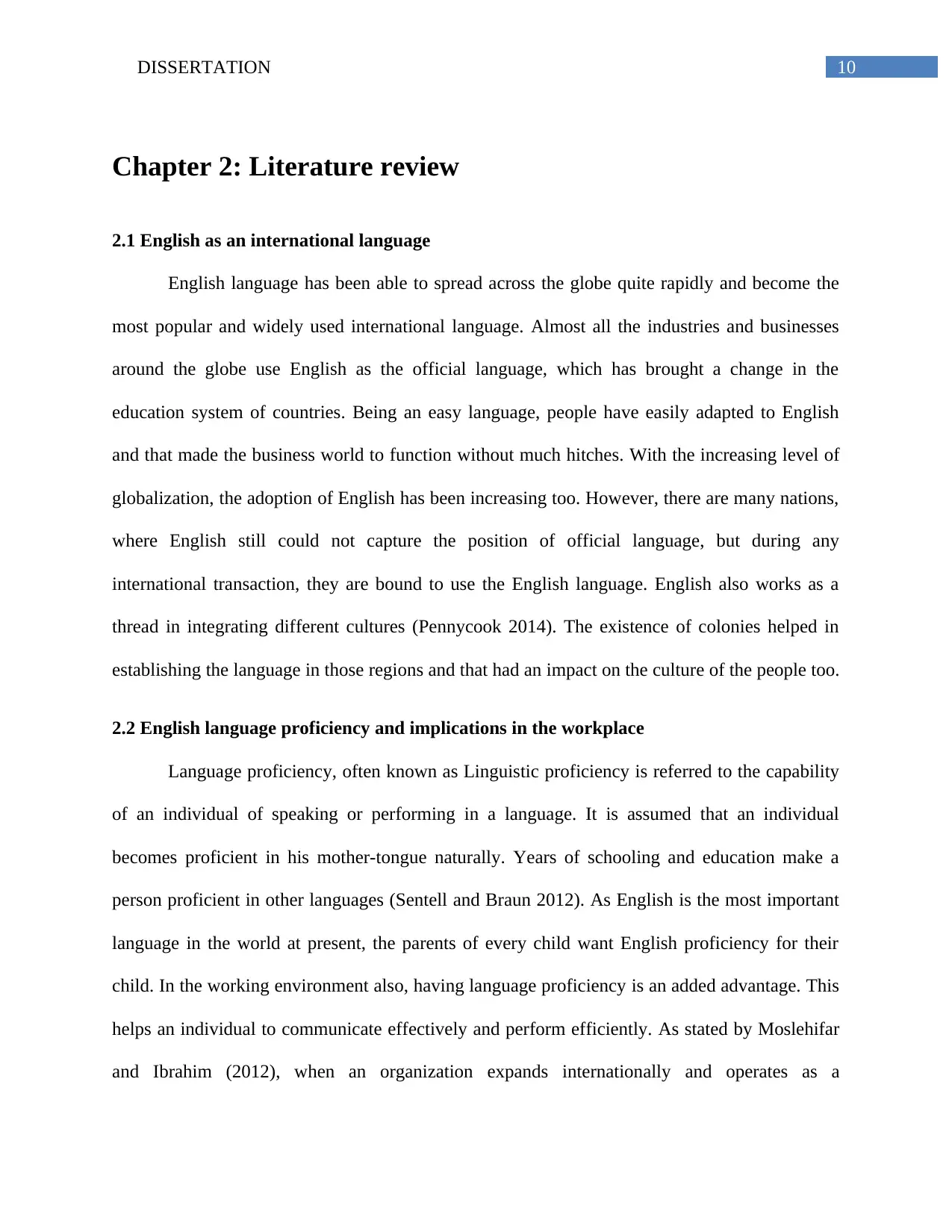
10DISSERTATION
Chapter 2: Literature review
2.1 English as an international language
English language has been able to spread across the globe quite rapidly and become the
most popular and widely used international language. Almost all the industries and businesses
around the globe use English as the official language, which has brought a change in the
education system of countries. Being an easy language, people have easily adapted to English
and that made the business world to function without much hitches. With the increasing level of
globalization, the adoption of English has been increasing too. However, there are many nations,
where English still could not capture the position of official language, but during any
international transaction, they are bound to use the English language. English also works as a
thread in integrating different cultures (Pennycook 2014). The existence of colonies helped in
establishing the language in those regions and that had an impact on the culture of the people too.
2.2 English language proficiency and implications in the workplace
Language proficiency, often known as Linguistic proficiency is referred to the capability
of an individual of speaking or performing in a language. It is assumed that an individual
becomes proficient in his mother-tongue naturally. Years of schooling and education make a
person proficient in other languages (Sentell and Braun 2012). As English is the most important
language in the world at present, the parents of every child want English proficiency for their
child. In the working environment also, having language proficiency is an added advantage. This
helps an individual to communicate effectively and perform efficiently. As stated by Moslehifar
and Ibrahim (2012), when an organization expands internationally and operates as a
Chapter 2: Literature review
2.1 English as an international language
English language has been able to spread across the globe quite rapidly and become the
most popular and widely used international language. Almost all the industries and businesses
around the globe use English as the official language, which has brought a change in the
education system of countries. Being an easy language, people have easily adapted to English
and that made the business world to function without much hitches. With the increasing level of
globalization, the adoption of English has been increasing too. However, there are many nations,
where English still could not capture the position of official language, but during any
international transaction, they are bound to use the English language. English also works as a
thread in integrating different cultures (Pennycook 2014). The existence of colonies helped in
establishing the language in those regions and that had an impact on the culture of the people too.
2.2 English language proficiency and implications in the workplace
Language proficiency, often known as Linguistic proficiency is referred to the capability
of an individual of speaking or performing in a language. It is assumed that an individual
becomes proficient in his mother-tongue naturally. Years of schooling and education make a
person proficient in other languages (Sentell and Braun 2012). As English is the most important
language in the world at present, the parents of every child want English proficiency for their
child. In the working environment also, having language proficiency is an added advantage. This
helps an individual to communicate effectively and perform efficiently. As stated by Moslehifar
and Ibrahim (2012), when an organization expands internationally and operates as a
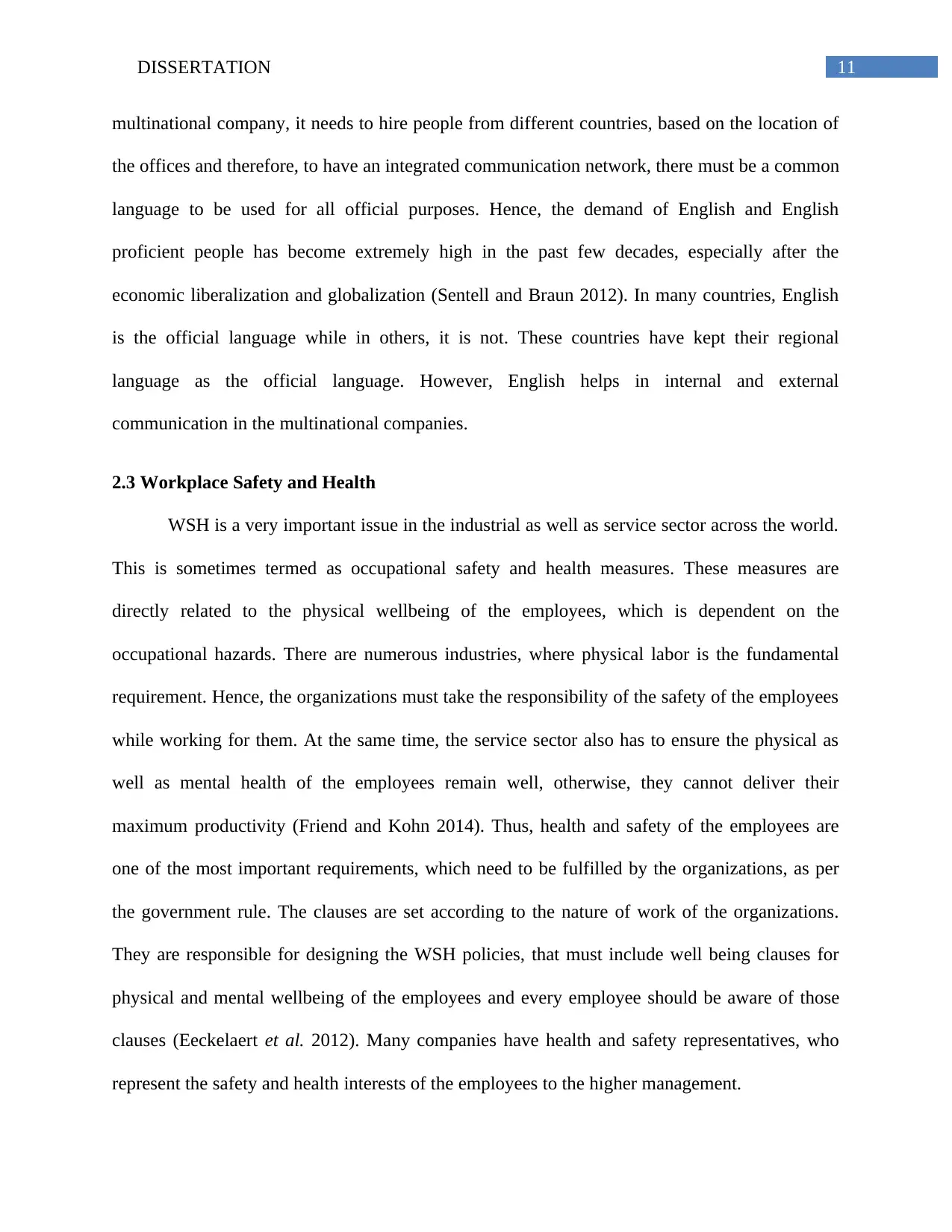
11DISSERTATION
multinational company, it needs to hire people from different countries, based on the location of
the offices and therefore, to have an integrated communication network, there must be a common
language to be used for all official purposes. Hence, the demand of English and English
proficient people has become extremely high in the past few decades, especially after the
economic liberalization and globalization (Sentell and Braun 2012). In many countries, English
is the official language while in others, it is not. These countries have kept their regional
language as the official language. However, English helps in internal and external
communication in the multinational companies.
2.3 Workplace Safety and Health
WSH is a very important issue in the industrial as well as service sector across the world.
This is sometimes termed as occupational safety and health measures. These measures are
directly related to the physical wellbeing of the employees, which is dependent on the
occupational hazards. There are numerous industries, where physical labor is the fundamental
requirement. Hence, the organizations must take the responsibility of the safety of the employees
while working for them. At the same time, the service sector also has to ensure the physical as
well as mental health of the employees remain well, otherwise, they cannot deliver their
maximum productivity (Friend and Kohn 2014). Thus, health and safety of the employees are
one of the most important requirements, which need to be fulfilled by the organizations, as per
the government rule. The clauses are set according to the nature of work of the organizations.
They are responsible for designing the WSH policies, that must include well being clauses for
physical and mental wellbeing of the employees and every employee should be aware of those
clauses (Eeckelaert et al. 2012). Many companies have health and safety representatives, who
represent the safety and health interests of the employees to the higher management.
multinational company, it needs to hire people from different countries, based on the location of
the offices and therefore, to have an integrated communication network, there must be a common
language to be used for all official purposes. Hence, the demand of English and English
proficient people has become extremely high in the past few decades, especially after the
economic liberalization and globalization (Sentell and Braun 2012). In many countries, English
is the official language while in others, it is not. These countries have kept their regional
language as the official language. However, English helps in internal and external
communication in the multinational companies.
2.3 Workplace Safety and Health
WSH is a very important issue in the industrial as well as service sector across the world.
This is sometimes termed as occupational safety and health measures. These measures are
directly related to the physical wellbeing of the employees, which is dependent on the
occupational hazards. There are numerous industries, where physical labor is the fundamental
requirement. Hence, the organizations must take the responsibility of the safety of the employees
while working for them. At the same time, the service sector also has to ensure the physical as
well as mental health of the employees remain well, otherwise, they cannot deliver their
maximum productivity (Friend and Kohn 2014). Thus, health and safety of the employees are
one of the most important requirements, which need to be fulfilled by the organizations, as per
the government rule. The clauses are set according to the nature of work of the organizations.
They are responsible for designing the WSH policies, that must include well being clauses for
physical and mental wellbeing of the employees and every employee should be aware of those
clauses (Eeckelaert et al. 2012). Many companies have health and safety representatives, who
represent the safety and health interests of the employees to the higher management.
⊘ This is a preview!⊘
Do you want full access?
Subscribe today to unlock all pages.

Trusted by 1+ million students worldwide
1 out of 35
Related Documents
Your All-in-One AI-Powered Toolkit for Academic Success.
+13062052269
info@desklib.com
Available 24*7 on WhatsApp / Email
![[object Object]](/_next/static/media/star-bottom.7253800d.svg)
Unlock your academic potential
Copyright © 2020–2025 A2Z Services. All Rights Reserved. Developed and managed by ZUCOL.





